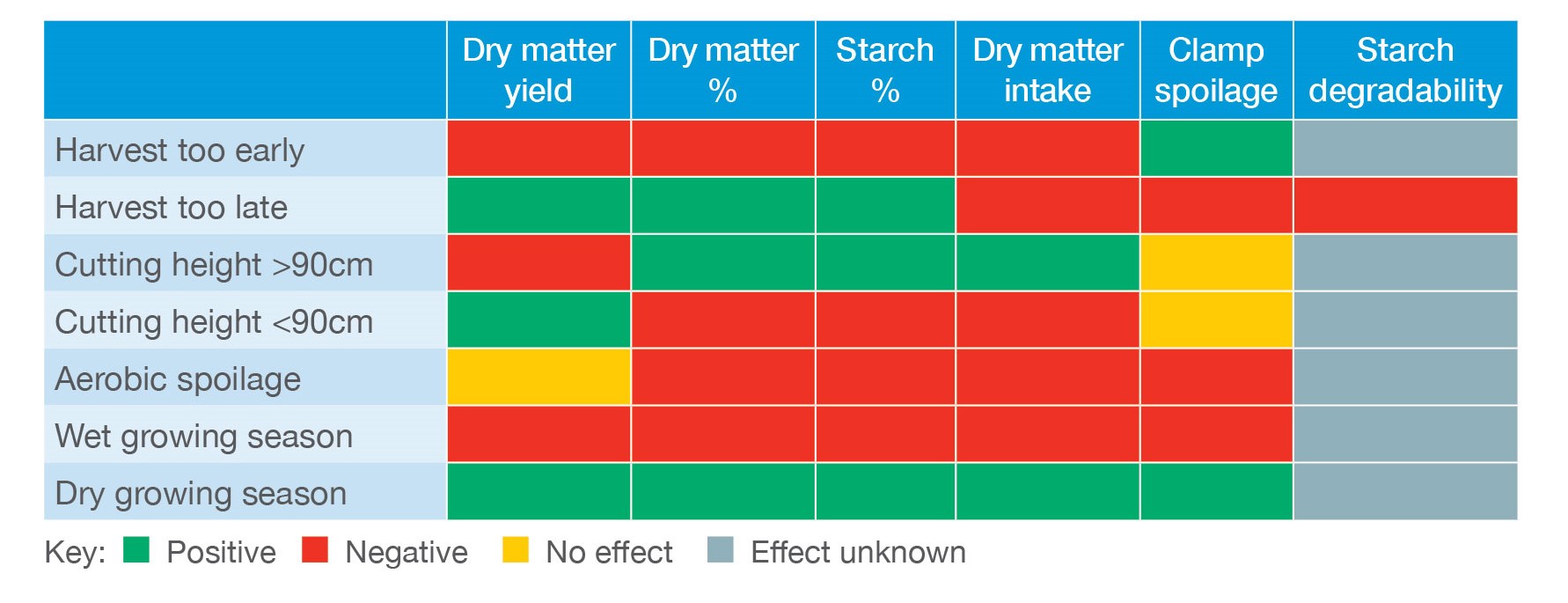- Home
- Knowledge library
- Feed value of maize silage and maize grain
Feed value of maize silage and maize grain
Maize is a high energy, high starch feed. Read more about how maize compares to grass silage for protein, energy, and dry matter.
Back to: Feeding maize silage for cattle and sheep
The benefits of feeding maize silage
- High energy, high starch
- Cattle and sheep adapt to it easily in rations
- Palatable
- Consistent feed value
Cattle fed rations containing maize silage tend to have a higher dry matter intake (DMI) than those fed rations based solely on grass silage. This extra DMI leads to higher energy intakes and should improve daily performance and feed efficiency when offered as part of a balanced diet.
The digestibility of maize remains fairly consistent throughout the growing season. As the crop matures, the quality of stem and leaf declines, but this is offset by the increase in grain in the cob, which is highly digestible and high in starch. This is why harvesting at the correct stage is essential to maximise nutritional value.
Generally, the mineral content of maize silage is relatively low, so supplementation is required. Check with a mineral supplier/nutritionist for appropriate specifications to add to maize-based diets for cattle and sheep. Maize also has a low protein content, so it should be fed with reasonably high-protein feeds.
Understanding maize analysis
Having an accurate nutritional analysis of conserved forages is essential when formulating rations so that they are used appropriately, accurately and cost-effectively. Six weeks after harvesting, take several core samples from the clamp for testing. Continue to test samples from the clamp face throughout the season, as feed value continues to change in the months after harvest.
Feed values for different forages
|
Feed type |
Dry matter (%) |
Metabolisable energy (MJ/kg DM) |
Crude protein (% in DM) |
Starch (% in DM) |
|
Maize silage |
28–35 |
10.8–11.5 |
8–9 |
25–35 |
|
Grass silage – first cut |
22–32 |
10.5–11.5 |
11–15 |
– |
|
Fermented wholecrop cereals |
30–45 |
9.5–10.5 |
9–17* |
15–22 |
|
Crimped maize grain |
65–70 |
13.8–14.3 |
9–10.5 |
65–70 |
|
Ground ear maize |
60–65 |
12.3–12.6 |
8.5–9 |
55–60 |
*Crude protein may be higher for cereals grown with bi-crops (e.g. peas, clover, vetches)
Factors affecting the yield and feeding value of maize silage

Maize grain
In southern England and the Midlands, maize grain is grown for crimping or whole cob maize, also known as ground ear maize (GEM). This is ensiled to feed as a concentrate, either conventionally combined with a maize ‘header’, or the whole cob is foraged through a forage harvester.
DM content
The optimum DM content of the grain for crimping at harvest is 65–70% and 60–65% for GEM, which is higher than for maize silage. Therefore, harvest is typically three to five weeks later, further restricting the areas where it can be grown. Choosing an early maturing variety is essential. Grain yield and standing power are also important characteristics to look for when buying seed.
The process of crimping or ‘milling’ through a forager for GEM breaks the outer seed coat of the kernel and reduces the particle size. This increases its digestibility and reduces any loss of grain through poor digestion.
Starch
Maize grain contains more starch and energy than other cereal grains and has a relatively high level of bypass starch. This travels through the rumen undegraded and is digested further down the digestive tract. This reduces the speed of fermentation and minimises possible dietary upset in a mixed cereal diet.
Protein
As with maize silage, additional protein, in particular effective rumen degradable protein (ERDP), is required to provide a well-balanced diet, along with a source of ‘long’ fibre to promote healthy rumen function.
Useful links
Download our guide to growing and feeding maize silage
To order a hard copy of the Growing and feeding maize for better returns manual or the Forage first guide, please contact publications@ahdb.org.uk or call 0247 799 0069.
Feeding cereal grains to livestock – the options
Learn how to calculate the dry matter (DM) of forage
Webinar: How to assess flooded forages and standing maize
Topics:
Sectors:
Tags:

